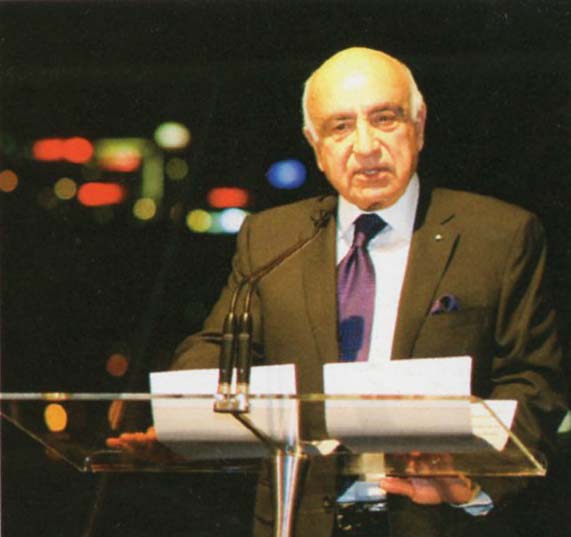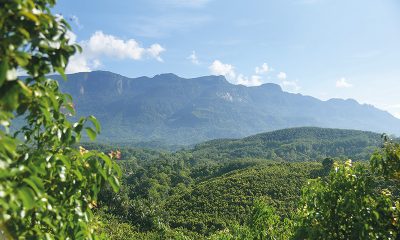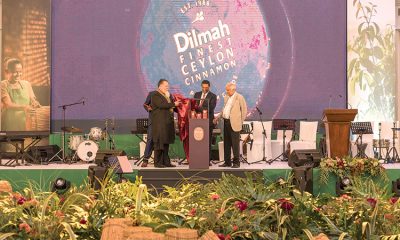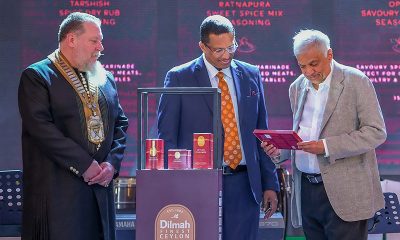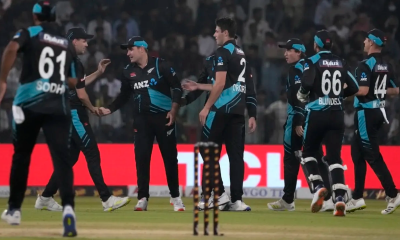Features
Entering Australia, early resistance and the platform for Dilmah’s success

(Excerpted from the Merrill Fernando autobiography)
Australia and neighbouring New Zealand feature very prominently in my story as it was in Australia, in 1985, that I launched ‘Dilmah’ as a brand. I was familiar with the markets in those two countries as I had been exporting to both since my early days in the export trade. I had also made very useful connections during my days as one of the major bulk tea suppliers from Sri Lanka to Australia.
The late Bill Bennet, who, in the early 1950s trained as a tea taster at Heath & Co in Colombo, where he represented Bushells’ interests, became a good friend. A very friendly, large-hearted man, at that time he was also very much a mentor to me. Later, he joined his father in the family tea company, H. A. Bennet & Sons in Australia and, eventually, became its owner. He sold much of my bulk tea in Australia.
In my move from bulk to branded tea, his advice and guidance were invaluable. As was the case with many of my business associates, he and his family became very close to mine. For close upon 50 years, we never failed to meet on my visits to Melbourne, Australia. I was deeply saddened by the recent passing of this gentle and generous man.
Bill introduced me to his brother, Peter, and Jack Sholer, who owned the Australian Tea & Coffee Company, which used to supply private label tea and coffee to supermarkets. Since the demand for tea bags was growing and their factory was unable to meet the production increase, they turned to me for help. It was a very useful opportunity for me as, soon afterwards, I made a major breakthrough when I was awarded the contract to pack ‘Farmland’ tea bags for G. J. Coles, then the largest supermarket chain in Australia.
Initially, as I will describe in a subsequent chapter, my export initiatives of value-added tea were inhibited by restrictions on shipping opportunities and the differentiated freight rates for bulk and value-added tea. Those issues had to be resolved with a mix of confrontation, subtlety, and influence leverage and, after a long battle, I was able to achieve a reasonable parity.
In 1977 I acquired two tea bagging machines at a cost of around USD 500,000, but for about two years I was unable to generate any business. Eventually, after relentless promotion on my part, personally carried out, I obtained a decent opening in the G. J. Coles supermarket chain. I developed private labels for Coles, Woolworths, Franklins, Safeway and other smaller supermarket chains, within a year.
Max Currie, Head of Tetley and Lyons Australia, and I, established a very good relationship and I supplied him with tea bags under the Tetley label. I also encountered episodes of sabotage of my tea, most likely by his staff, as they would have feared that Max might transfer all the Tetley business in Sri Lanka to me. I went across to Australia and proved that a cigarette butt, which was allegedly found in one of my packs from Sri Lanka, would, most probably, have been introduced at the Aussie end, as that cigarette brand was not available in Sri Lanka! Eventually, after they secured their own tea bagging machines, I stopped supplying that label.
This was also a period of stringent exchange control regulations. Spending money abroad, even for genuine businessmen, was restricted to 10 pounds sterling per day for a 21-day maximum. Max was aware of this issue and was always generous to me with spending money, which was very useful. Despite my protests he continued this practice even after controls were relaxed.
Max was also the Chairman of the Victoria Economic Council, a very influential position in a Labour Party Government body. He offered me some very generous concessions, including a proposal for me to transfer tea bagging machines and to set up an operation in Melbourne, for which he would find the necessary land. He also offered me funding through the Economic Council. However, I explained to him that my philosophy was to provide employment in my country and to ensure that the benefits of value addition would remain in Sri Lanka.
His wife, Meris, too became our friend as she was especially fond of both Malik and Dilhan. She presented them with lovely sweaters and other woollen clothing when they were schooling in England. Max moved on a few years ago but Meris continues to live in Melbourne and I do not fail to meet her whenever I visit that city.
Why Dilmah?
`DILMAH, ‘the brand name that now symbolizes Quality Pure Ceylon Tea in over a hundred countries, was coined by combining the names of my two sons, Dilhan and Malik. When I linked the names of my two sons to my brand, I was demonstrating my commitment to my promise to deliver a quality product at a reasonable price, and the credibility of my pledge to the customer. My brand was as part of my family as my two sons were. In retrospect, despite the early setbacks and the initial misgivings of advertising and marketing experts about the potential of a brand name, which, in their view, did not seem linked to tea, it proved to be one of the best marketing decisions I had ever made.
The trial launch took place in 1985, in Australia, with a decent-looking but by no means impressive pack. This was well before the art of the graphic designer and five colour printing. I designed my own pack and first called it ‘Dilma’. I was then 55 years old and close to the age when most people retire!
My friend Gamini Goonesena, formerly a famous cricketer both in England and Sri Lanka, was then working for the Australian advertising agency, appointed by the Sri Lanka Tea Board, as the official media company for the promotion of Sri Lanka tea brands in Australia. Gamini helped me source a distributor, Aeroplane Jelly, a small, family-owned, jelly-producing company. I selected it because they had good access to the retail trade, especially in New South Wales.
However, I made slow progress with them and it soon became clear that the challenge of marketing a new product category like tea, in a highly-competitive environment, was beyond their capabilities. Therefore, I moved to Mauri Foods whilst George Patterson, a leading advertising agency, re-designed the package, which remains much the same to this day.
Patterson developed a new campaign strategy, with one of the first key initiatives being consumer testing of the brand name, ‘Dilma’. The results indicated that ‘Dilma’ did not have sufficient punch to create significant brand awareness and visibility. There were doubts about its appeal to a highly-sophisticated market like Australia. However, the creation of a new brand name was out of the question; quite apart from the sunk costs and the prohibitive additional cost of rebranding, my sentimental attachment to the brand name precluded any such consideration.
Finally, following rigorous consumer testing, it was decided to add the ‘H’ at the end of ‘Dilma’ and rebrand as ‘Dilmah’. Thus the brand was born. It was relaunched with a new packaging design, which was printed in Singapore to ensure highest quality in presentation.
Early struggles
I came up against stiff resistance when I tried to find a supermarket chain which would give ‘Dilmah’ space on its shelves. The Coles supermarket chain buyer whom I approached maintained that he was happy with the tea brands he was already selling and that he did not see the need to add to the portfolio of selling brands which had been around for generations. I had many friendly arguments with him, trying to get him to understand that big brand owners were simply looking for profit, without any concern for the consumer, who is driven to buy whatever is on the shelf, regardless of the quality of the product.
I tried to convince him that what was on the shelf was commodity tea and that whilst the brand names remained the same, the contents had changed and the consumers, who had been weaned on quality Ceylon Tea, were now being deceived by an inferior product. Finally, either convinced by my arguments or simply to appease my insistence, he accepted two Dilmah products and put genuine, quality Ceylon Tea back on the Coles supermarket shelf.
It was also a watershed moment in my life as a tea entrepreneur; for the first 38 years I had been supplying tea in bulk to blenders and packers around the world. With the launching of my own brand, ‘Dilmah,’ I took the first steps towards the fulfilment of a promise I had made to myself, as a young man in his novitiate in the tea trade.
Initially, despite my long experience in tea and my knowledge of multinational marketing strategies, I was still a bit naive. It was my intention to price Dilmah 20 cents above the market leader, but the Coles buyer would not agree. In deference to his opinion and advice, I priced it at AUS Dollars 1.89, 10 cents less. I was delighted with what I had achieved, in ignorance of what was to follow.
As Dilmah was relatively small, unknown, and, in my perception, posed no threat to the established multinational brands, I never expected a reaction from them. However, the then market leader discounted its tea to AUS Dollars 1.49 at the very next promotion. I was both disappointed and dispirited. I assumed that my long-held dream to bring Pure Ceylon Tea back to the consumer would have to remain as such. I fully expected Dilmah to be taken off the shelves when it came up for review three months later.
The Dilmah philosophy was a threat to the multinational operational style. The foundation of the latter, a well-entrenched colonial concept, is to subjugate the producer by acquiring his product in bulk, as a raw material, and to add real value by branding, packaging, and marketing elsewhere. Dilmah had broken that mould by adding that value in the country of production itself. If many others were to follow that example, the mass market traders’ business would be at serious risk. Hence, the immediate retaliatory response in Australia, which included aggressive media campaigns mounted by Lipton, Bushells and Lanchoo the then market leaders to counter my entry in to the Australian market with Dilmah.
Therefore, in the background of an envisaged worst case scenario, I was rendered speechless when, at my next visit to the Coles buyer, he said: “I have good news for you.” Apparently, never before had he received so many messages from happy customers, as he did about Dilmah, commending the product. The callers had thanked Coles for bringing real Ceylon Tea back in to their cups. That marked the beginning of the Dilmah success and the confirmation of my long-held belief, that if you deliver good quality consistently, the consumer will extend patronage. The brand is built and sustained by the happy customer.
Australia was a market with other, inherent advantages for a proposition such as Dilmah, as that market offered many house brands and generic packs, largely of Ceylon Tea. Whilst all such packs were under importers’ brands, with suppliers and origins changing from time to time, it was still an important part of Australian business and a pattern of trade and distribution common in other Western countries as well.
The opportunity given to me earlier, to provide such house brands and generic packs to retailers, gave me an invaluable insight in to the dynamics of the Australian tea market. That experience with the distribution system, and my connections with the retailers and their management, enabled me to very effectively introduce my own brand later.
Having first worked with Mauri Foods, I moved to Cerebos Australia whilst working with a few other foodservice importers. Subsequently, with the sales of Dilmah gathering momentum, I set up ‘Dilmah Australia’ as a company and a marketing platform, to operate in association with Broker Counterpoint Marketing Services. The latter functioned as regional brokers whilst we managed the customers and logistics through a logistics company. I recruited Cindy Dean, wife of a good friend, Ishan Ratnam, as the General Manager of Dilmah Australia. Thus, with my own team in place, I was beginning to achieve my goals for Dilmah in Australia.
However, I found that our distributors did not always share my passion for Dilmah and, as a result, I had to constantly review marketing strategies and distribution arrangements. One disappointing experience was with Valcorp, in 2008. I found that this company, headed by John Valmobida, did not possess the competencies and attributes necessary to drive Dilmah with the kind of energy that I liked to see. Finally, when we were unable to arrive at a resolution of issues regarding distribution of Dilmah in Sydney, Valmobida suggested that the operations agreement between us be cancelled.
I immediately agreed and resisted all his subsequent attempts to change my mind. From then on, having given Valcorp a couple of months’ grace, we set up our own distribution, eventually managed by Rohan Meegama, the son of my Shipping Manager when I was at A. F. Jones. Rohan was the Warehouse Manager for Valcorp and, despite the misgivings of both colleagues and friends, I set him up in the warehousing business on his own and entrusted our distribution in Australia to him. He has been doing an excellent job ever since.
Consequences of stress
That was a particularly trying time for me personally as, under the strain of resolving problems that were cropping up in all the major cities in Australia where we were in business, I actually fell physically ill. I was flying between cities almost on a daily basis and as a result of developing a seemingly unquenchable thirst, consuming large quantities of lemonade and other carbonated drinks. It was one of the most stressful periods in my life.
After a very strenuous spell in Australia I returned to Colombo soon afterwards, flew to London, still feeling terribly unwell but understanding the reason. A couple of days after I landed, the late Daya de Silva, then my doctor in London, diagnosed that I had come in for Type 2 Diabetes! An incipient condition had been triggered in to a major health episode by work stress. He wanted to immediately hositalize me but agreed to let me stay at home on the strict understanding that I would ring him twice a day, to personally report on my condition.
In the launching and promotion of Dilmah tea in Australia, I had to contend with humiliation, disappointment, and interventions designed to damage my progress. In addition, there was also opposition from people in Sri Lanka itself. However, whilst I was deeply shaken by the fierce and often unscrupulous competition from the multinationals, I was also inspired by the welcome reception to the concept of a quality tea that I eventually received from the supermarket buyer and the consumer. My persistence at that level paid off and resulted in supermarket chains agreeing to stock my products.
A refreshing counterpoint to the initial hostility I faced in Australia was the friendly reception, from the Romeo & Drake families of Adelaide, both running independent supermarket chains in South Australia. My association with these two families goes back to over 40 years. In the charming nature of such close-knit, traditional family businesses, very much like mine, the relationship has been extended to the second and third generations.
Rodney Arambawela, a proactive official
Rodney was Sri Lanka’s Tea Commissioner in the Middle East (Gulf Region) from 1975-1982. During this period of service he was stationed in Dubai, before it became the sophisticated and modern centre of business activity that it is today. I got to know him then and shared with him, my ideas for the launch of a Pure Ceylon Tea brand of my own.
In 1982, during Major Jayawickrema’s period as Minister of Plantation Industries, Rodney was appointed as Tea Commissioner to Australia, New Zealand, and the Pacific Islands. His appointment came at a time when the market for Ceylon Tea in Australia had declined alarmingly, with Australian packers opting for cheaper tea from different origins, more suitable for tea bags. Rodney’s remit in Australia, as defined by the minister himself, was to strategize the revitalization of the Ceylon Tea market in the country.
Apart from my own knowledge of the Australian market, the market research that Rodney conducted after assuming duties in Australia, provided statistics which were very helpful in the launch of Dilmah in that country. He was also very supportive in the early promotional campaigns and took an active part in the related activities. His proactive response to the project, and his enthusiasm for its successful implementation, was in complete contrast to the passive and often obstructionist attitude of some of the members of the Secretariat in Colombo. After leaving the Tea Board in 1988, Rodney reverted to an academic career but still continued his promotion of Dilmah in various forums. His assistance to the cause of Dilmah in Australia has been invaluable.
Nabi Saleh my friend
My story of Dilmah in Australia would not be complete without mention of Nabi Saleh, a highly-educated, Iranian-Australian businessman and commodities trader. I met Nabi, quite unexpectedly, about 40 years ago at the Franklins Supermarket, Sydney, whilst we were both waiting to meet the same buyer, Michael Hansel. We were competitors at first. but later became trade associates and, more importantly, good friends.
Nabi was then a private label supplier to Franklins and other distributors. through a small-time packer in Indonesia. After that first meeting. Nabi bought private label tea from me as well. In 1995 Nabi became the owner/Chief Executive Officer of Gloria Jean’s Coffee, a venture he developed into a worldwide success. Nabi admired my vision for Pure Ceylon Tea and was of assistance to me in establishing Dilmah in Australia. Like me, Nabi is also a man of great faith.
Features
The heart-friendly health minister

by Dr Gotabhya Ranasinghe
Senior Consultant Cardiologist
National Hospital Sri Lanka
When we sought a meeting with Hon Dr. Ramesh Pathirana, Minister of Health, he graciously cleared his busy schedule to accommodate us. Renowned for his attentive listening and deep understanding, Minister Pathirana is dedicated to advancing the health sector. His openness and transparency exemplify the qualities of an exemplary politician and minister.
Dr. Palitha Mahipala, the current Health Secretary, demonstrates both commendable enthusiasm and unwavering support. This combination of attributes makes him a highly compatible colleague for the esteemed Minister of Health.
Our discussion centered on a project that has been in the works for the past 30 years, one that no other minister had managed to advance.
Minister Pathirana, however, recognized the project’s significance and its potential to revolutionize care for heart patients.
The project involves the construction of a state-of-the-art facility at the premises of the National Hospital Colombo. The project’s location within the premises of the National Hospital underscores its importance and relevance to the healthcare infrastructure of the nation.
This facility will include a cardiology building and a tertiary care center, equipped with the latest technology to handle and treat all types of heart-related conditions and surgeries.
Securing funding was a major milestone for this initiative. Minister Pathirana successfully obtained approval for a $40 billion loan from the Asian Development Bank. With the funding in place, the foundation stone is scheduled to be laid in September this year, and construction will begin in January 2025.
This project guarantees a consistent and uninterrupted supply of stents and related medications for heart patients. As a result, patients will have timely access to essential medical supplies during their treatment and recovery. By securing these critical resources, the project aims to enhance patient outcomes, minimize treatment delays, and maintain the highest standards of cardiac care.
Upon its fruition, this monumental building will serve as a beacon of hope and healing, symbolizing the unwavering dedication to improving patient outcomes and fostering a healthier society.We anticipate a future marked by significant progress and positive outcomes in Sri Lanka’s cardiovascular treatment landscape within the foreseeable timeframe.
Features
A LOVING TRIBUTE TO JESUIT FR. ALOYSIUS PIERIS ON HIS 90th BIRTHDAY

by Fr. Emmanuel Fernando, OMI
Jesuit Fr. Aloysius Pieris (affectionately called Fr. Aloy) celebrated his 90th birthday on April 9, 2024 and I, as the editor of our Oblate Journal, THE MISSIONARY OBLATE had gone to press by that time. Immediately I decided to publish an article, appreciating the untiring selfless services he continues to offer for inter-Faith dialogue, the renewal of the Catholic Church, his concern for the poor and the suffering Sri Lankan masses and to me, the present writer.
It was in 1988, when I was appointed Director of the Oblate Scholastics at Ampitiya by the then Oblate Provincial Fr. Anselm Silva, that I came to know Fr. Aloy more closely. Knowing well his expertise in matters spiritual, theological, Indological and pastoral, and with the collaborative spirit of my companion-formators, our Oblate Scholastics were sent to Tulana, the Research and Encounter Centre, Kelaniya, of which he is the Founder-Director, for ‘exposure-programmes’ on matters spiritual, biblical, theological and pastoral. Some of these dimensions according to my view and that of my companion-formators, were not available at the National Seminary, Ampitiya.
Ever since that time, our Oblate formators/ accompaniers at the Oblate Scholasticate, Ampitiya , have continued to send our Oblate Scholastics to Tulana Centre for deepening their insights and convictions regarding matters needed to serve the people in today’s context. Fr. Aloy also had tried very enthusiastically with the Oblate team headed by Frs. Oswald Firth and Clement Waidyasekara to begin a Theologate, directed by the Religious Congregations in Sri Lanka, for the contextual formation/ accompaniment of their members. It should very well be a desired goal of the Leaders / Provincials of the Religious Congregations.
Besides being a formator/accompanier at the Oblate Scholasticate, I was entrusted also with the task of editing and publishing our Oblate journal, ‘The Missionary Oblate’. To maintain the quality of the journal I continue to depend on Fr. Aloy for his thought-provoking and stimulating articles on Biblical Spirituality, Biblical Theology and Ecclesiology. I am very grateful to him for his generous assistance. Of late, his writings on renewal of the Church, initiated by Pope St. John XX111 and continued by Pope Francis through the Synodal path, published in our Oblate journal, enable our readers to focus their attention also on the needed renewal in the Catholic Church in Sri Lanka. Fr. Aloy appreciated very much the Synodal path adopted by the Jesuit Pope Francis for the renewal of the Church, rooted very much on prayerful discernment. In my Religious and presbyteral life, Fr.Aloy continues to be my spiritual animator / guide and ongoing formator / acccompanier.
Fr. Aloysius Pieris, BA Hons (Lond), LPh (SHC, India), STL (PFT, Naples), PhD (SLU/VC), ThD (Tilburg), D.Ltt (KU), has been one of the eminent Asian theologians well recognized internationally and one who has lectured and held visiting chairs in many universities both in the West and in the East. Many members of Religious Congregations from Asian countries have benefited from his lectures and guidance in the East Asian Pastoral Institute (EAPI) in Manila, Philippines. He had been a Theologian consulted by the Federation of Asian Bishops’ Conferences for many years. During his professorship at the Gregorian University in Rome, he was called to be a member of a special group of advisers on other religions consulted by Pope Paul VI.
Fr. Aloy is the author of more than 30 books and well over 500 Research Papers. Some of his books and articles have been translated and published in several countries. Among those books, one can find the following: 1) The Genesis of an Asian Theology of Liberation (An Autobiographical Excursus on the Art of Theologising in Asia, 2) An Asian Theology of Liberation, 3) Providential Timeliness of Vatican 11 (a long-overdue halt to a scandalous millennium, 4) Give Vatican 11 a chance, 5) Leadership in the Church, 6) Relishing our faith in working for justice (Themes for study and discussion), 7) A Message meant mainly, not exclusively for Jesuits (Background information necessary for helping Francis renew the Church), 8) Lent in Lanka (Reflections and Resolutions, 9) Love meets wisdom (A Christian Experience of Buddhism, 10) Fire and Water 11) God’s Reign for God’s poor, 12) Our Unhiddden Agenda (How we Jesuits work, pray and form our men). He is also the Editor of two journals, Vagdevi, Journal of Religious Reflection and Dialogue, New Series.
Fr. Aloy has a BA in Pali and Sanskrit from the University of London and a Ph.D in Buddhist Philosophy from the University of Sri Lankan, Vidyodaya Campus. On Nov. 23, 2019, he was awarded the prestigious honorary Doctorate of Literature (D.Litt) by the Chancellor of the University of Kelaniya, the Most Venerable Welamitiyawe Dharmakirthi Sri Kusala Dhamma Thera.
Fr. Aloy continues to be a promoter of Gospel values and virtues. Justice as a constitutive dimension of love and social concern for the downtrodden masses are very much noted in his life and work. He had very much appreciated the commitment of the late Fr. Joseph (Joe) Fernando, the National Director of the Social and Economic Centre (SEDEC) for the poor.
In Sri Lanka, a few religious Congregations – the Good Shepherd Sisters, the Christian Brothers, the Marist Brothers and the Oblates – have invited him to animate their members especially during their Provincial Congresses, Chapters and International Conferences. The mainline Christian Churches also have sought his advice and followed his seminars. I, for one, regret very much, that the Sri Lankan authorities of the Catholic Church –today’s Hierarchy—- have not sought Fr.
Aloy’s expertise for the renewal of the Catholic Church in Sri Lanka and thus have not benefited from the immense store of wisdom and insight that he can offer to our local Church while the Sri Lankan bishops who governed the Catholic church in the immediate aftermath of the Second Vatican Council (Edmund Fernando OMI, Anthony de Saram, Leo Nanayakkara OSB, Frank Marcus Fernando, Paul Perera,) visited him and consulted him on many matters. Among the Tamil Bishops, Bishop Rayappu Joseph was keeping close contact with him and Bishop J. Deogupillai hosted him and his team visiting him after the horrible Black July massacre of Tamils.
Features
A fairy tale, success or debacle

Sri Lanka-Singapore Free Trade Agreement
By Gomi Senadhira
senadhiragomi@gmail.com
“You might tell fairy tales, but the progress of a country cannot be achieved through such narratives. A country cannot be developed by making false promises. The country moved backward because of the electoral promises made by political parties throughout time. We have witnessed that the ultimate result of this is the country becoming bankrupt. Unfortunately, many segments of the population have not come to realize this yet.” – President Ranil Wickremesinghe, 2024 Budget speech
Any Sri Lankan would agree with the above words of President Wickremesinghe on the false promises our politicians and officials make and the fairy tales they narrate which bankrupted this country. So, to understand this, let’s look at one such fairy tale with lots of false promises; Ranil Wickremesinghe’s greatest achievement in the area of international trade and investment promotion during the Yahapalana period, Sri Lanka-Singapore Free Trade Agreement (SLSFTA).
It is appropriate and timely to do it now as Finance Minister Wickremesinghe has just presented to parliament a bill on the National Policy on Economic Transformation which includes the establishment of an Office for International Trade and the Sri Lanka Institute of Economics and International Trade.
Was SLSFTA a “Cleverly negotiated Free Trade Agreement” as stated by the (former) Minister of Development Strategies and International Trade Malik Samarawickrama during the Parliamentary Debate on the SLSFTA in July 2018, or a colossal blunder covered up with lies, false promises, and fairy tales? After SLSFTA was signed there were a number of fairy tales published on this agreement by the Ministry of Development Strategies and International, Institute of Policy Studies, and others.
However, for this article, I would like to limit my comments to the speech by Minister Samarawickrama during the Parliamentary Debate, and the two most important areas in the agreement which were covered up with lies, fairy tales, and false promises, namely: revenue loss for Sri Lanka and Investment from Singapore. On the other important area, “Waste products dumping” I do not want to comment here as I have written extensively on the issue.
1. The revenue loss
During the Parliamentary Debate in July 2018, Minister Samarawickrama stated “…. let me reiterate that this FTA with Singapore has been very cleverly negotiated by us…. The liberalisation programme under this FTA has been carefully designed to have the least impact on domestic industry and revenue collection. We have included all revenue sensitive items in the negative list of items which will not be subject to removal of tariff. Therefore, 97.8% revenue from Customs duty is protected. Our tariff liberalisation will take place over a period of 12-15 years! In fact, the revenue earned through tariffs on goods imported from Singapore last year was Rs. 35 billion.
The revenue loss for over the next 15 years due to the FTA is only Rs. 733 million– which when annualised, on average, is just Rs. 51 million. That is just 0.14% per year! So anyone who claims the Singapore FTA causes revenue loss to the Government cannot do basic arithmetic! Mr. Speaker, in conclusion, I call on my fellow members of this House – don’t mislead the public with baseless criticism that is not grounded in facts. Don’t look at petty politics and use these issues for your own political survival.”
I was surprised to read the minister’s speech because an article published in January 2018 in “The Straits Times“, based on information released by the Singaporean Negotiators stated, “…. With the FTA, tariff savings for Singapore exports are estimated to hit $10 million annually“.
As the annual tariff savings (that is the revenue loss for Sri Lanka) calculated by the Singaporean Negotiators, Singaporean $ 10 million (Sri Lankan rupees 1,200 million in 2018) was way above the rupees’ 733 million revenue loss for 15 years estimated by the Sri Lankan negotiators, it was clear to any observer that one of the parties to the agreement had not done the basic arithmetic!
Six years later, according to a report published by “The Morning” newspaper, speaking at the Committee on Public Finance (COPF) on 7th May 2024, Mr Samarawickrama’s chief trade negotiator K.J. Weerasinghehad had admitted “…. that forecasted revenue loss for the Government of Sri Lanka through the Singapore FTA is Rs. 450 million in 2023 and Rs. 1.3 billion in 2024.”
If these numbers are correct, as tariff liberalisation under the SLSFTA has just started, we will pass Rs 2 billion very soon. Then, the question is how Sri Lanka’s trade negotiators made such a colossal blunder. Didn’t they do their basic arithmetic? If they didn’t know how to do basic arithmetic they should have at least done their basic readings. For example, the headline of the article published in The Straits Times in January 2018 was “Singapore, Sri Lanka sign FTA, annual savings of $10m expected”.
Anyway, as Sri Lanka’s chief negotiator reiterated at the COPF meeting that “…. since 99% of the tariffs in Singapore have zero rates of duty, Sri Lanka has agreed on 80% tariff liberalisation over a period of 15 years while expecting Singapore investments to address the imbalance in trade,” let’s turn towards investment.
Investment from Singapore
In July 2018, speaking during the Parliamentary Debate on the FTA this is what Minister Malik Samarawickrama stated on investment from Singapore, “Already, thanks to this FTA, in just the past two-and-a-half months since the agreement came into effect we have received a proposal from Singapore for investment amounting to $ 14.8 billion in an oil refinery for export of petroleum products. In addition, we have proposals for a steel manufacturing plant for exports ($ 1 billion investment), flour milling plant ($ 50 million), sugar refinery ($ 200 million). This adds up to more than $ 16.05 billion in the pipeline on these projects alone.
And all of these projects will create thousands of more jobs for our people. In principle approval has already been granted by the BOI and the investors are awaiting the release of land the environmental approvals to commence the project.
I request the Opposition and those with vested interests to change their narrow-minded thinking and join us to develop our country. We must always look at what is best for the whole community, not just the few who may oppose. We owe it to our people to courageously take decisions that will change their lives for the better.”
According to the media report I quoted earlier, speaking at the Committee on Public Finance (COPF) Chief Negotiator Weerasinghe has admitted that Sri Lanka was not happy with overall Singapore investments that have come in the past few years in return for the trade liberalisation under the Singapore-Sri Lanka Free Trade Agreement. He has added that between 2021 and 2023 the total investment from Singapore had been around $162 million!
What happened to those projects worth $16 billion negotiated, thanks to the SLSFTA, in just the two-and-a-half months after the agreement came into effect and approved by the BOI? I do not know about the steel manufacturing plant for exports ($ 1 billion investment), flour milling plant ($ 50 million) and sugar refinery ($ 200 million).
However, story of the multibillion-dollar investment in the Petroleum Refinery unfolded in a manner that would qualify it as the best fairy tale with false promises presented by our politicians and the officials, prior to 2019 elections.
Though many Sri Lankans got to know, through the media which repeatedly highlighted a plethora of issues surrounding the project and the questionable credentials of the Singaporean investor, the construction work on the Mirrijiwela Oil Refinery along with the cement factory began on the24th of March 2019 with a bang and Minister Ranil Wickremesinghe and his ministers along with the foreign and local dignitaries laid the foundation stones.
That was few months before the 2019 Presidential elections. Inaugurating the construction work Prime Minister Ranil Wickremesinghe said the projects will create thousands of job opportunities in the area and surrounding districts.
The oil refinery, which was to be built over 200 acres of land, with the capacity to refine 200,000 barrels of crude oil per day, was to generate US$7 billion of exports and create 1,500 direct and 3,000 indirect jobs. The construction of the refinery was to be completed in 44 months. Four years later, in August 2023 the Cabinet of Ministers approved the proposal presented by President Ranil Wickremesinghe to cancel the agreement with the investors of the refinery as the project has not been implemented! Can they explain to the country how much money was wasted to produce that fairy tale?
It is obvious that the President, ministers, and officials had made huge blunders and had deliberately misled the public and the parliament on the revenue loss and potential investment from SLSFTA with fairy tales and false promises.
As the president himself said, a country cannot be developed by making false promises or with fairy tales and these false promises and fairy tales had bankrupted the country. “Unfortunately, many segments of the population have not come to realize this yet”.
(The writer, a specialist and an activist on trade and development issues . )


